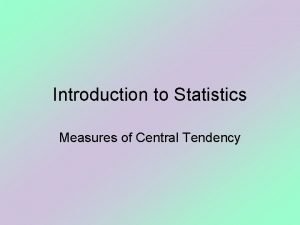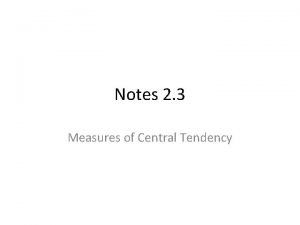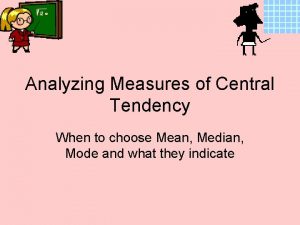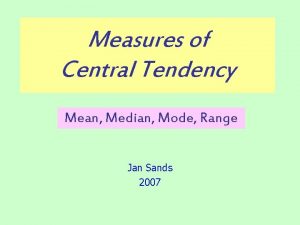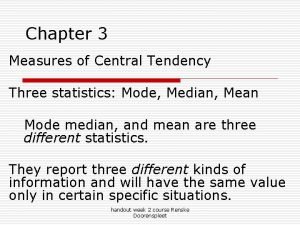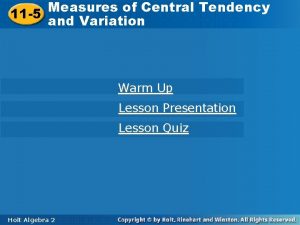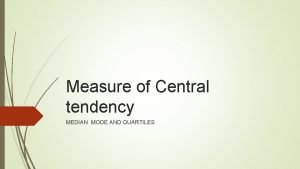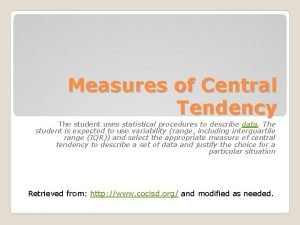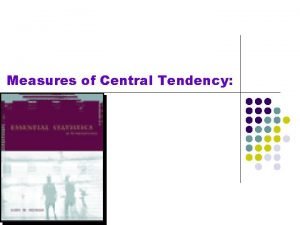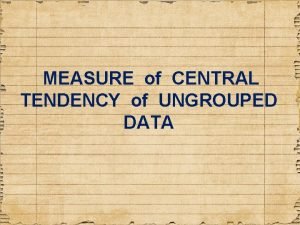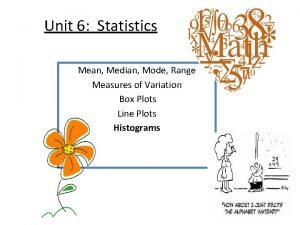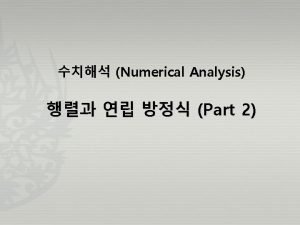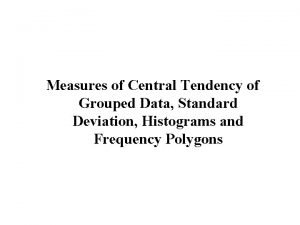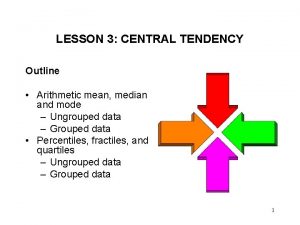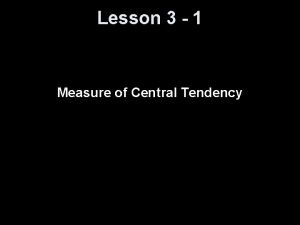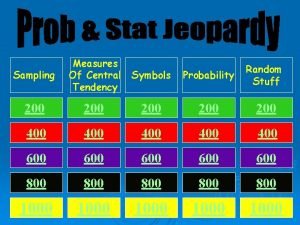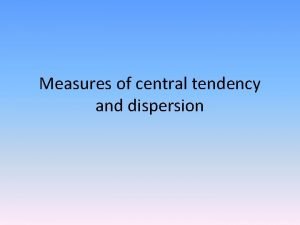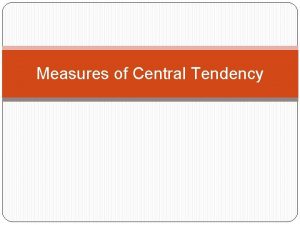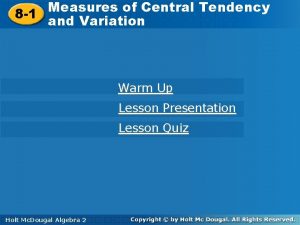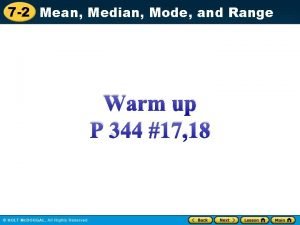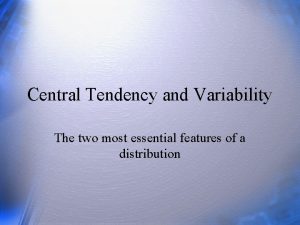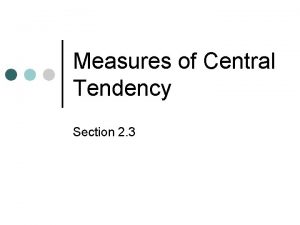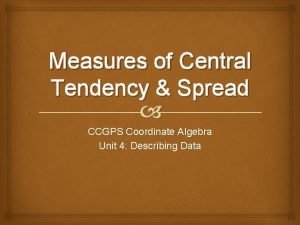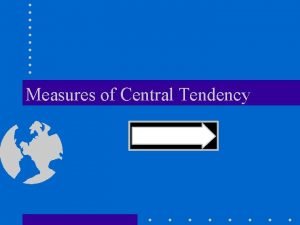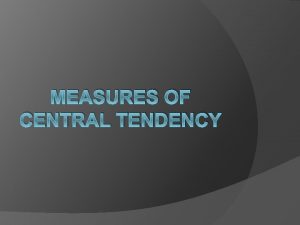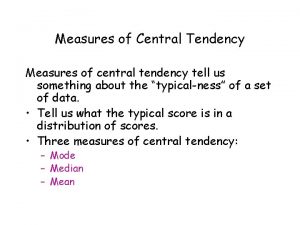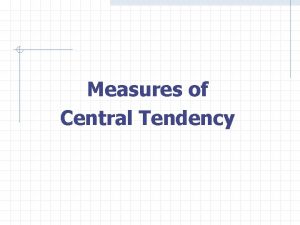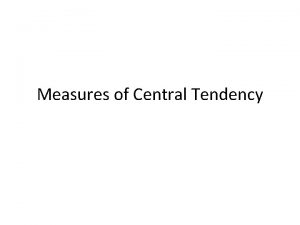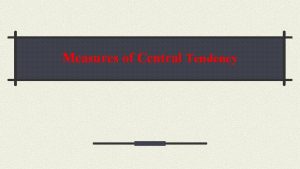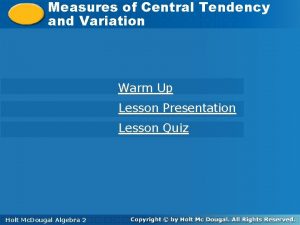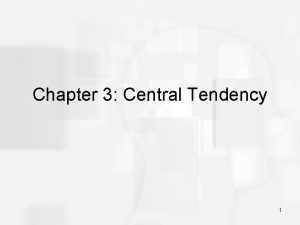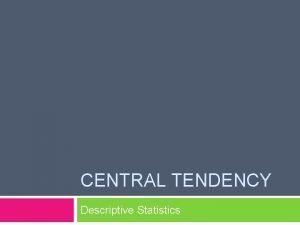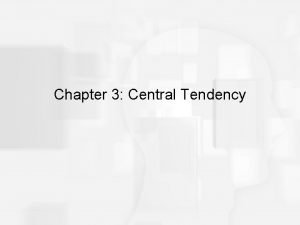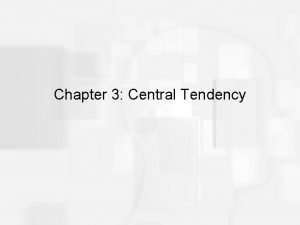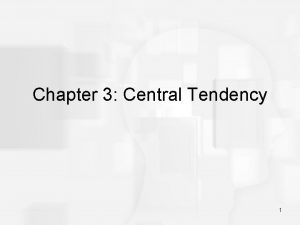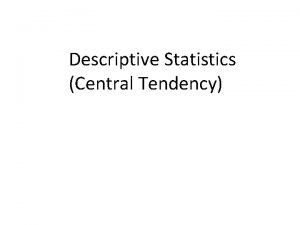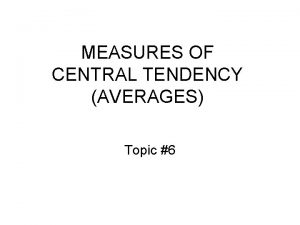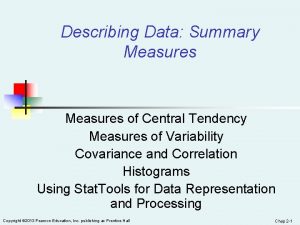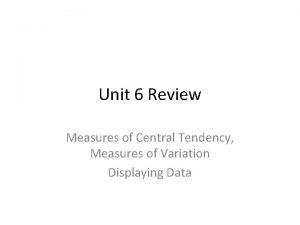MEASURES OF CENTRAL TENDENCY MEASURES OF CENTRAL TENDENCY


























- Slides: 26

MEASURES OF CENTRAL TENDENCY

MEASURES OF CENTRAL TENDENCY What is a measure of central tendency? Measures of Central Tendency Mode Median Mean Shape of the Distribution Considerations for Choosing an Appropriate Measure of Central Tendency

WHAT IS A MEASURE OF CENTRAL TENDENCY? • Numbers that describe what is average or typical of the distribution • You can think of this value as where the middle of a distribution lies.

WHY CAN’T THE MEAN TELL US EVRYTHING? Mean describes Central Tendency, what the average outcome is. We also want to know something about how accurate the mean is when making predictions. The question becomes how good a representation of the distribution is the mean? How good is the mean as a description of central tendency -- or how good is the mean as a predictor? Answer -- it depends on the shape of the distribution. Is the distribution normal or skewed?

THE MODE • The category or score with the largest frequency (or percentage) in the distribution. • The mode can be calculated for variables with levels of measurement that are: nominal, ordinal, or interval-ratio.

MODE AN EXAMPLE Example: Number of Votes for Candidates for Mayor. The mode, in this case, gives you the “central” response of the voters: the most popular candidate. Candidate A – 11, 769 votes The Mode: Candidate B – 39, 443 votes “Candidate C” Candidate C – 78, 331 votes

Measures of Central Tendency One further parameter of a population that may give some indication of central tendency of the data is the mode Define: mode = most frequently occurring value in the population From the previous data we see: 65, 67, 68, 69, 71, 71, 72, 72, 73, 73, 74, 75, 75, 76, 77, 77, 77, 78, 78, 79, 79, 80, 81, 81, 82, 83, 84, 85, 85, 86, 87, 88, 89, 92 That the value 81 occurs 8 times mode = 81 Note! If two different values were to occur most frequently, the distribution would be bimodal. A distribution may be multi-modal.

MOST COMMON OUTCOME Male Female

The score that divides the distribution into two equal parts, so that half the cases are above it and half below it. The median is the middle score, or average of middle scores in a distribution.

TO COMPUTE THE MEDIAN first you rank order the values of X from low to high: 85, 94, 96, 96, 97, 98 · then count number of observations = 10. · add 1 = 11. · divide by 2 to get the middle score the 5 ½ score here 96 is the middle score ·

EXAMPLE OF MEDIAN (N IS ODD) Calculate the median for this hypothetical distribution: TEMPERATURE Very High Frequency 2 High 3 Moderate 5 Low 7 Very Low 4 TOTAL 21

MEDIAN EXERCISE (N IS EVEN) Calculate the median for this hypothetical distribution: TEMPERATURE Frequency Very High 5 High 7 Moderate 6 Low 7 Very Low 3 TOTAL 28

MEDIAN Find the Median 4 5 6 6 7 8 9 10 12 Find the Median 5 6 6 7 8 9 10 100, 000

Measures of Central Tendency A second measure of central tendency is the median The median of a population of size N is found by 1. Arranging the individual measurements in ascending order, and 2. If N is odd, selecting the value in the middle of this list as the median (there will be the same number of values above and below the median) 3. If N is even find the values at position N/2 and N/2 + 1 in this list (call them x. N/2 and x. N/2+1) and let median be given by the formula median = (x. N/2 + x. N/2+1)/2 or be the value halfway between these two measurements. Note! When N is even the median will usually not be an actual value in the population

Measures of Central Tendency We now find the median of the population of temperature readings 87, 85, 79, 75, 81, 88, 92, 86, 77, 72, 75, 77, 81, 80, 77, 73, 69, 71, 76, 79, 83, 81, 78, 75, 68, 67, 71, 73, 78, 75, 84, 81, 79, 82, 87, 89, 85, 81, 79, 77, 81, 78, 74, 76, 82, 85, 86, 81, 72, 69, 65, 71, 73, 78, 81, 77, 74, 77, 72, 68 Arrange these 60 measurements in ascending order 65, 67, 68, 69, 71, 71, 72, 72, 73, 73, 74, 75, 75, 76, 77, 77, 77, 78, 78, 79, 79, 80, 81, 81, 82, 83, 84, 85, 85, 86, 87, 88, 89, 92 Since N/2 = 30 and both the 30 th and 31 st values in the list are the same, we obtain median = 78

THE MEAN The arithmetic average obtained by adding up all the scores and dividing by the total number of scores.

FORMULA FOR THE MEAN “X bar” represents MEAN

FINDING THE MEAN • X = (Σ X) / N • If X = {3, 5, 10, 4, 3} X = (3 + 5 + 10 + 4 + 3) / 5 = 25 / 5 = 5

CALCULATING THE MEAN WITH GROUPED SCORES where: fx = a score multiplied by its frequency

MEAN: GROUPED SCORES From the table we obtain Class Midpoint (x) Total (f) Frequency f*x 64. 5 - 69. 5 67 6 0. 100 402 69. 5 – 74. 5 72 11 0. 183 792 74. 5 – 79. 5 77 20 0. 333 1540 79. 5 – 84. 5 82 13 0. 217 1066 84. 5 – 89. 5 87 9 0. 150 783 89. 5 – 94. 5 92 1 60 0. 0167 92 4675

MERITS AND DEMERITS OF MEAN MERITS 1. It is easy to calculate 2. It is easy to follow DEMERITS 1. It is highly effected by extreme values 2. It cannot average the ratios and percentage properly

MEAN FOR DISCRETE SERIES Number of People(x) 1 2 3 4 5 6 TOTAL Frequency(f) 190 316 54 17 2 2 581

SHAPE OF THE DISTRIBUTION Symmetrical (mean is about equal to median) Negatively (example: years of education) mean < median Positively (example: income) mean > median Bimodal (two distinct modes) Multi-modal (more than 2 distinct modes)

DISTRIBUTION SHAPE

Measures of Central Tendency Next we show where each of these parameters occur in the frequency distribution graph for this tabulated data. Frequency % 42 39 36 33 30 27 24 21 18 15 12 9 6 3 0 Mean = 79. 183 Median = 78 x Midrange = 78. 5 Mode = 81 x x median mean x 67 72 77 82 87 92 Temperature

THANK YOU
 Measures of central tendency
Measures of central tendency Measures of central tendency notes
Measures of central tendency notes Choosing the best measure of central tendency worksheets
Choosing the best measure of central tendency worksheets Range in central tendency
Range in central tendency Statistics chapter 3 measures of central tendency
Statistics chapter 3 measures of central tendency Measures of central tendency and variation
Measures of central tendency and variation Lower boundary of the median class calculator
Lower boundary of the median class calculator Measures of central tendency median
Measures of central tendency median Measures of central tendency
Measures of central tendency Central tendency
Central tendency Central tendency symbols
Central tendency symbols Mode in statistics
Mode in statistics Measures of central tendency
Measures of central tendency Measures of central location for grouped data
Measures of central location for grouped data How to do percentile calculation
How to do percentile calculation Mode of grouped data
Mode of grouped data Objectives of central tendency
Objectives of central tendency Central tendency symbols
Central tendency symbols Advantages of measures of central tendency
Advantages of measures of central tendency Objective of central tendency
Objective of central tendency Measures of central tendency and variation
Measures of central tendency and variation Example of measure of central tendency
Example of measure of central tendency Central tendency symbols
Central tendency symbols Central tendency and variability
Central tendency and variability Central tendency symbols
Central tendency symbols Central tendency and spread homework
Central tendency and spread homework Summation notation
Summation notation
